
The Caridea, commonly known as caridean shrimp or true shrimp, are an infraorder of shrimp within the order Decapoda. This infraorder contains all species of true shrimp. They are found widely around the world in both fresh and salt water. Many other animals with similar names – such as the mud shrimp of Axiidea and the boxer shrimp of Stenopodidea – are not true shrimp, but many have evolved features similar to true shrimp.

The Stenopodidea or boxer shrimps are a small group of decapod crustaceans. Often confused with Caridea shrimp or Dendrobranchiata prawns, they are neither, belonging to their own group.

Stenopus hispidus is a shrimp-like decapod crustacean belonging to the infraorder Stenopodidea. Common names include coral banded shrimp and banded cleaner shrimp.
Charles Spence Bate, FRS was a British zoologist and dentist.

Palaemon is a genus of caridean shrimp of the family Palaemonidae. The conventional circumscription of the genus Palaemon is probably paraphyletic. Molecular data suggest that Palaemonetes, as well as the genera Exopalaemon and Couteriella, are nested within Palaemon. Phylogenetic affinities in these groups correspond better with geographical origin than conventional genus assignments.
Troglocaris anophthalmus is a species of freshwater shrimp in the family Atyidae. It lives in karstic caves in Bosnia and Herzegovina, Croatia, Italy and Slovenia. Although morphologically similar across its 500-kilometre (310 mi) range, molecular phylogenetics suggests that there are four or five cryptic lineages with more restricted ranges, although one such lineage does range unusually widely for a troglobite – over 300 kilometres (190 mi).
Procarididea is an infraorder of decapods, comprising only eleven species. Six of these are in the genera Procaris and Vetericaris, which together make up the family Procarididae. The remaining five species are only known from fossils and belong to the genus Udora, which cannot yet be assigned to any family. Use of molecular phylogenetics suggests that the procarids are the sister group to the Caridea, and are thus recognised as a separate infraorder, Procarididea.

Lysmata is a genus of shrimp in the infraorder Caridea, the caridean shrimp. The genus belongs to the family Lysmatidae. Lysmata are popular ornamental shrimp in the marine aquarium trade for their bright color patterns, interesting behaviors, and ability to control certain aquarium pests such as sea anemones of the genus Aiptasia. They are known to command high prices on the pet market.
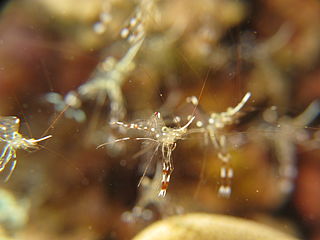
Urocaridella antonbruunii, common names clear cleaner shrimp or red-white cleaner shrimp, is a species of shrimp belonging to the family Palaemonidae. It was described by A. J. Bruce in 1967. It is one of the species that are known as cleaner shrimps.
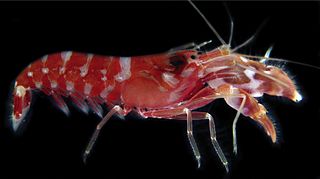
Alpheoidea is a superfamily of shrimp containing the families Alpheidae, Barbouriidae, Hippolytidae and Ogyrididae.

Nematocarcinoidea is a superfamily of shrimp, comprising four families – Eugonatonotidae, Nematocarcinidae, Rhynchocinetidae and Xiphocarididae. They share the presence of strap-like epipods on at least the first three pairs of pereiopods, and a blunt molar process.
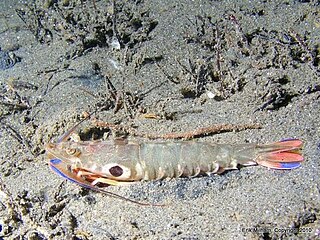
Sicyonia is a genus of prawns, placed in its own family, Sicyoniidae. It differs from other prawns in that the last three pairs of its pleopods are uniramous, rather than biramous as seen in all other prawns.
Juxtastenopus spinulatus is a species of stenopodidean shrimp. It lives in the Red Sea, and across the Indian Ocean as far east as the Philippines. It is red or pink, up to 28 mm (1.1 in) long, with enlarged third pereiopods. Originally described in the genus Engystenopus, it is now placed in the monotypic genus Juxtastenopus, in the family Stenopodidae.

Thor is a genus of shrimp, containing the following species:

Prawn is a common name for small aquatic crustaceans with an exoskeleton and ten legs, some of which can be eaten.
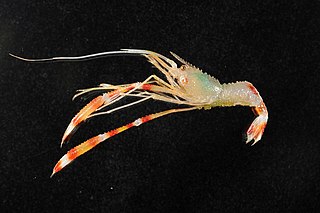
Stenopus scutellatus, commonly known as the gold coral banded shrimp or golden coral shrimp, is a boxer shrimp, a shrimp-like decapod crustacean belonging to the family Stenopodidae. It is found in suitable habitats in the western Atlantic and the Caribbean Sea.

Periclimenaeus is a genus of decapod crustaceans of the family Palaemonidae which is part of the infraorder Caridea. The genus was named by the English carcinologist Lancelot Alexander Borradaile in 1915. He set out the distinguishing features of the genus as:
Body rather stout, cephalothorax deep, a good deal compressed, abdomen greatly curved Thorax without dorsal swelling. Rostrum rather short, compressed, toothed above only. Outer antennular flagellum not deeply cleft. Antennal scale of good breadth. Mandible without palp. Second maxilliped without podopalp. Third maxilliped narrow, with vestigial arthrobranch.
Parhippolyte is a genus of cave dwelling decapod crustaceans, known as cave shrimps from the family Barbouriidae The type species Parhipplyte uvea was described in 1900 by the English carcinologist Lancelot Alexander Borradaile from specimens collected in the south western Pacific by Arthur Willey. As their vernacular name of cave shrimp suggests these species are generally found in marine caves as well as anchialine ponds and lagoons.
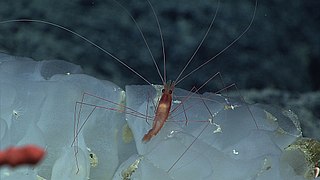
Nematocarcinus tenuisrostris, or long-legged shrimp, is a species of shrimp known from the Indian and Pacific Oceans.

Periclimenes, commonly known as glass shrimp or cleaner shrimp, is a commensal and often symbiotic genus of semi-transparent shrimp within the family Palaemonidae. Species of this large genus feature a wide variety of coloration and patterns, widespread distribution throughout much of the world's tropical oceans, and are often sought out for aquarium trade.















